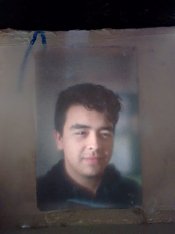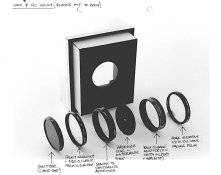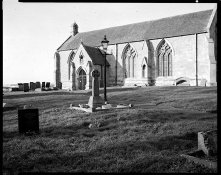I've been trying to find info on this, but have really not come up with much. I've been fiddling with building a couple of pinhole cameras, but now I would want something with a bit more speed on the lens. Not much but enough to get exposure times down enough to be able to try in-camera calotypes or the like.So is it possible to make simple objectives from microscope lenses or something? Thanks!
-
Welcome to Photrio!Registration is completely free and logged-in members see fewer ads.Click here to sign up
- Home
- Forums
- Analog Workflow Forums (100% Analog/Traditional)
- Analog Equipment
- Camera Building, Repairs & Modification
You are using an out of date browser. It may not display this or other websites correctly.
You should upgrade or use an alternative browser.
You should upgrade or use an alternative browser.
Building primitive lens cameras
-
A
- Thread starter onkeltuka
- Start date
Recent Classifieds
-
Sold Nikon 1 V1 w/10-30mm VR &/Grip Low Shutter Count
- Started by Acere
-
Free Saunders Multi-Print 8x10 Easel - Free for the cost of Shipping and Packaging
- Started by Todd Barlow
-
Want to Buy Schneider 135mm 5.6 APO Symmar
- Started by ediz7531
-
Want to Buy Leedal Stainless Steel 16x20 Developing Trays
- Started by Grayjohn900
-
Want to Buy Schneider Xenotar 135mm f3.5 Super-Technika in Minty Condition
- Started by Christopherjs
Forum statistics
John Koehrer
Member
Zone plates would be faster but I don't believe they're as sharp.
I actually cancelled my Amazon order as I found eBooks.com had it as an e-book for a passable price.
My next question would be where to look for useable lenses to use in self-made builds? The book doesn't say anything about that...
My next question would be where to look for useable lenses to use in self-made builds? The book doesn't say anything about that...
ciniframe
Member
- Joined
- Jul 3, 2014
- Messages
- 803
- Format
- Sub 35mm
Close up lenses can be used on simple lens cameras. A plus 2 diopter has a focal length of 500mm for instance. Or using 8x10 film holders a plus 3 close up lens, at 333mm would have a ‘normal’ angle of view. Used at f32 to f64 should give passable image quality.
Or, look up ‘Wollaston landscape lens‘ for a discussion of simple, single lens objectives.
One of the advertisers on this forum, re-inventedphotoequip.com sells them also.
Or, look up ‘Wollaston landscape lens‘ for a discussion of simple, single lens objectives.
One of the advertisers on this forum, re-inventedphotoequip.com sells them also.
Last edited:
removed account4
Subscriber
- Joined
- Jun 21, 2003
- Messages
- 29,832
- Format
- Hybrid
do you have an enlarger lens -- use one of its elements, you can also take a folding camera or box camera and remove the lens from that. if you have an optic shops nearby? we have the "surplus shed" and "anchor optical" here in the states and they sell Plano convex lenses /lens making supplies. they are very inexpensive, weigh very little and I am guessing the shipping would be minimal.
have fun !
John
have fun !
John
Close up lenses can be used on simple lens cameras. A plus 2 diopter has a focal length of 500mm for instance. Or using 8x10 film holders a plus 3 close up lens, at 333mm would have a ‘normal’ angle of view. Used at f32 to f64 should give passable image quality.
Or, look up ‘Wollaston landscape lens‘ for a discussion of simple, single lens objectives.
One of the advertisers on this forum, re-inventedphotoequip.com sells them also.
I started digging through some boxes and I actually do have these two Minolta close-up lenses, 55mm no 1&2.
I don't want to scrap my enlarger lens, but there's a Canon zoom from an old Eos-500 that I could sacrifice... And a pair of old binoculars...

Dan Fromm
Member
- Joined
- Mar 23, 2005
- Messages
- 6,890
- Format
- Multi Format
Not to be a complete idiot, but if you want to use primitive lenses any camera with an in-built shutter will do. View cameras, if that's what you have in mind, generally don't have shutters but there are ways to mount many, not all, lenses in front of a leaf shutter. And there are roller blind shutters ...
On the whole, you'd be better off working on lenses and not trying to build a camera.
On the whole, you'd be better off working on lenses and not trying to build a camera.
ciniframe
Member
- Joined
- Jul 3, 2014
- Messages
- 803
- Format
- Sub 35mm
The Minolta Close up lenses should have even better results as they are high quality two element cemented achromats.I started digging through some boxes and I actually do have these two Minolta close-up lenses, 55mm no 1&2.
I don't want to scrap my enlarger lens, but there's a Canon zoom from an old Eos-500 that I could sacrifice... And a pair of old binoculars...
Are there any websites or other resources on lenses and optics in general, to understand a bit more about the basics?The Minolta Close up lenses should have even better results as they are high quality two element cemented achromats.
Steve906
Subscriber
HiAre there any websites or other resources on lenses and optics in general, to understand a bit more about the basics?
Have a look at https://www.edmundoptics.com/knowledge-center/glossary
Loads of really detailed stuff but with a bit of digging around there's also loads of the basics.
Just leave the glossary bit off for a complete overview.
-edit-
Also just found this again
http://hyperphysics.phy-astr.gsu.edu/hbase/geoopt/lenseq.html
Lots of leads to other stuff here too.
Last edited:
Donald Qualls
Subscriber
Zone plates would be faster but I don't believe they're as sharp.
A photon seive is the sharpest of the "faster than pinhole" glassless optics. Like a zone plate (and unlike a pinhole), it has a specific focal length, but it produces far sharper images with a "glow". Even better, it can be made in a solid material, because it's holes in a plane, rather than a series of complete rings -- so no substrate needs to pass the imaging light. It's slower than a zone plate (because it's holes instead of rings), but much faster than a pinhole.
Read the book yesterday. The problem is, the wood sizes and types described for use in the book are really hard to come by here in the EU... even just converting the really exact measures from inches to millimeters leaves too much variance. Without having built a camera before it's pretty difficult to start improvising with slightly different wood sizes etc. Does anyone know if it's possible to contact Mr. Greene by any means? Or has anybody actually built the cameras in his book?
Oh, and there are very good lenses also for sale at https://www.edmundoptics.com/c/clearance-optics/836/#
Oh, and there are very good lenses also for sale at https://www.edmundoptics.com/c/clearance-optics/836/#
Máx Arnold
Member
I've been interested on building lens cameras for a while.
I found the lens part was the easiest. As Talbot discovered back in the day, smaller cameras with smaller lenses make shorter focal lengths, brighter images, faster exposures. Talbot's wife called his cameras "mousetraps", because they resembled them.
I found that a couple of magnifying glasses from the office supply store attached one over the other gives shorter focal lengths. (If both have the same length, it's cut by a half).
If you want to shoot 8 x 10 I don't really suggest shorter focal lengths, but a magnifying glass is usually better than it seems.
Edit: most magnifying glasses have very long focal length ie. 60 cm
Using two might work well
I found the lens part was the easiest. As Talbot discovered back in the day, smaller cameras with smaller lenses make shorter focal lengths, brighter images, faster exposures. Talbot's wife called his cameras "mousetraps", because they resembled them.
I found that a couple of magnifying glasses from the office supply store attached one over the other gives shorter focal lengths. (If both have the same length, it's cut by a half).
If you want to shoot 8 x 10 I don't really suggest shorter focal lengths, but a magnifying glass is usually better than it seems.
Edit: most magnifying glasses have very long focal length ie. 60 cm
Using two might work well
Last edited:
Donald Qualls
Subscriber
If you use office store magnifying glasses, especially in pairs, you can expect a lot of chromatic aberration (= image softness in black and white, at least with panchromatic film), spherical aberration (specific kinds of focus defects), coma (ditto), and field curvature (center focal distance differs from edge focal distance).
That said, all of those can produce effects some photographers enjoy.
A positive meniscus lens, concave to the subject, mounted behind an aperture of f/11 to f/22, was a formula that produced literally millions of pretty good box camera images over the past 125 years...
That said, all of those can produce effects some photographers enjoy.
A positive meniscus lens, concave to the subject, mounted behind an aperture of f/11 to f/22, was a formula that produced literally millions of pretty good box camera images over the past 125 years...
Máx Arnold
Member
That's just awesome. The meniscus lens seems something to research in.
I personally posted what I did because I had good results using the technique above.
(I find most of the aberrations to come from the lenses being dirty, which is something I can't avoid)
Below I post a photo I took from a view camera I made using two magnifying glasses "sandwiched" together.
The f/ number was very low, and the depth of field shallow af.
(The shallow depth of filed might counteract here, but I don't see why we couldn't stop this lens down a bit)
I personally posted what I did because I had good results using the technique above.
(I find most of the aberrations to come from the lenses being dirty, which is something I can't avoid)
Below I post a photo I took from a view camera I made using two magnifying glasses "sandwiched" together.
The f/ number was very low, and the depth of field shallow af.
(The shallow depth of filed might counteract here, but I don't see why we couldn't stop this lens down a bit)
Attachments
Tony39
Member
I have built a few cameras over the years and my most successful lens was made from two close up lenses mounted back to back - see images. Mine were 2 dioptre and 3 dioptre so it is advisable to mount them with the stronger lens to the subject and the weaker to the film. Film in my case was 8x10 Multigrade print paper.
I made waterhouse stops out of thin brass sheet and Araldited various filter rings together to make the mount. I duplicated the spacers to centralise the stop. Maximum aperture was around f8.
I include an image made with the lens.
Hope it might be of interest.
I made waterhouse stops out of thin brass sheet and Araldited various filter rings together to make the mount. I duplicated the spacers to centralise the stop. Maximum aperture was around f8.
I include an image made with the lens.
Hope it might be of interest.
Attachments
Tony39
Member
I don't think the distance isn't too critical but mine were effectively four filter mounts apart, roughly 1cm I guess, with the aperture approximately central. I think with a 1 and 2 dioptre combination the focal length will be longer. The results can be remarkably sharp, but the negative was 10x8 and so not too much enlargement is needed. It might be a little less crisp with a smaller format and I was using a smallish aperture. There would be be much more fall off of definition at wide apertures which would suit a less record type of image than mine..
Donald Qualls
Subscriber
A diopter is an inverse measurement, equivalent to 1/f with f the focal length in meters. That is, a +1 has a 1000 mm focal length, +2 has 500mm, and so forth. Diopters are used because they're convenient for calculating lens combinations; just add the diopter strengths before converting back to focal length -- a +6, -4, +2 triplet would have a net +4 diopter or 250 mm focal length.
So, your +1 and +2 would give a 333 mm focal length for the pair (maybe a hair shorter if you have space between).
What you're creating this way is a slight variation on the Rapid Rectilinear -- meniscus lenses with flats in place of the concave side, convex out on both ends. There's a formula for spacing the groups in an RR, and you'd put the aperture halfway between when the groups are identical -- it's probably more complicated if they're not quite the same.
So, your +1 and +2 would give a 333 mm focal length for the pair (maybe a hair shorter if you have space between).
What you're creating this way is a slight variation on the Rapid Rectilinear -- meniscus lenses with flats in place of the concave side, convex out on both ends. There's a formula for spacing the groups in an RR, and you'd put the aperture halfway between when the groups are identical -- it's probably more complicated if they're not quite the same.
| Photrio.com contains affiliate links to products. We may receive a commission for purchases made through these links. To read our full affiliate disclosure statement please click Here. |
PHOTRIO PARTNERS EQUALLY FUNDING OUR COMMUNITY:  |




